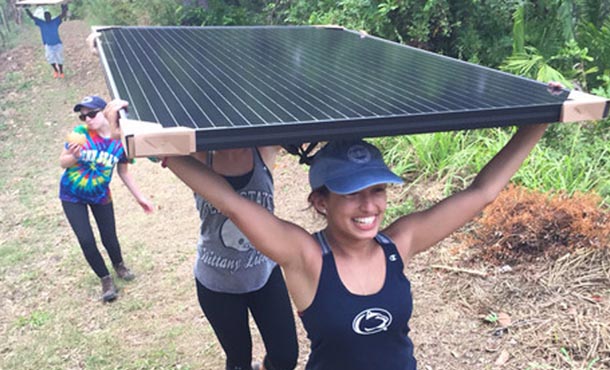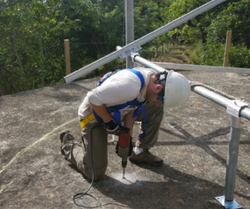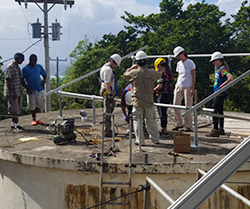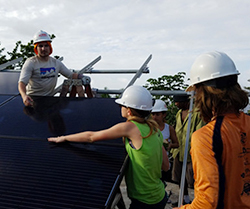
Penn State students carry a solar panel. The students installed a solar array to power a community water pump in a low-income village in Honduras.
Students install solar array in low-income community in Honduras
4/28/2017
ROATAN, Honduras — During spring break, 13 Penn State students in the colleges of Earth and Mineral Sciences and Engineering joined a team of partners to build a solar array in a low-income village in Roatan, Honduras. The project is the sixth of its kind completed through the Renew Crew program at Penn State, all of which were led by David Riley, associate professor of architectural engineering. The Renew Crew is a group within the Penn State student chapter of the National Electrical Contractors’ Association (NECA).
Roatan is a small island off the coast of Honduras. Like many island communities, it struggles to meet energy needs and relies on imported fossil fuels to generate electricity. Throughout the Caribbean, island governments and utilities are turning to renewable energy as an alternative.
“In many communities like Punta Gorda, the high cost of electricity is the limiting factor for communities to provide water to families,” said Riley. “As a result, they only pump water sporadically. It is not uncommon for homes to get water only once a week."
Prior to heading to Roatan, the students participated in a 1-credit course to learn about the applications of solar energy in emerging communities.
After they arrived, students worked with a local electrical contractor and project partner, Vegas Electric, to prefabricate components of the solar array and transport the equipment to the hilltop jobsite. After three days of hard work, the 36 solar modules and electrical equipment were complete, and the system was successfully started up.
“The project was very gratifying,” said Allison Midget, a sophomore majoring in civil and environmental engineering. “The day after we completed the project, Raul, the pump operator, shared that the solar array reduced the electricity use for that day by 50 percent — and that was on a cloudy day!”
“For us, it was a week where we could do something good and have some fun, but the impact we made changed the lives of the community there,” said Rachel Hennessey, a junior majoring in energy engineering and president of the Penn State NECA chapter.
Hands-on work with the community
The students anticipated they would be spending the week completing hands-on, sometimes challenging physical labor, but they did not expect to have as many helpers as they had.
“There were always community members helping us, whether they were lifting solar modules onto the cisterns, drilling holes, getting tools, bringing us snacks or helping us carry stuff,” said Hennessey, who hails from Kennett Square, Pennsylvania. “Everyone was way more hands-on than I expected. And they were so happy we were there.”
That community involvement was one of the group’s goals during the week.
“We tried to focus on engaging the community so they knew what we were doing there, why the solar array was important and how it would benefit them,” said Taylor Clayton, a junior majoring in energy business and finance.
The students focused on visiting with community leaders to provide outreach and education during their visit.
“One of the best parts of the project was the chance to work with community members during construction,” said Jessica Smith, a senior majoring in architectural engineering. “The men and women of Punta Gorda were very welcoming and anxious to help us.”
The students also took time to meet with local teachers and presented a miniature solar water pumping display to the teachers to help them teach about solar energy.
“One of the highlights of the trip was listening to a teacher explain solar energy to her students using the poster and model that we made for them,” said Angela Peretti, a senior majoring in architectural engineering.
In addition to building the solar array, the students prepared outreach materials to help the community learn about how the solar system works. These efforts included a bilingual brochure to distribute and an operation manual for the pump operator.
“It is important to help the pump operators learn how to operate the system,” said Riley. “If they are careful, they are able to pump water more frequently than before and still save quite a bit of money — money that can be used for other important needs in the community.”
Reflecting on the experience, the group said the trip was rewarding in so many intangible ways.
“We feel honored to have been invited to Roatan to help promote and deploy solar energy. Over time, we have learned a great deal, and our projects have helped build interest and momentum,” said Riley.
“Nothing has ever felt as genuine as the gratitude expressed by the community members,” Hennessey said. “I encourage everyone — if you have a chance to do something like this, a service trip is the most amazing opportunity. Helping out a community is very eye opening and is worth the travel expenses just to have this experience.”
The Renew Crew program was launched in 2009 with a grant from the ELECTRI International Foundation as a collaborative effort of academic programs and student organizations focused on the deployment of solar photovoltaic systems in developing communities. Beginning with a small solar installation on a school in Roatan, the initiative has evolved to a strategic initiative targeting community water wells. A part of this evolution has been the shift from a project focus to a long-term effort to create systemic change on the island of Roatan and contribute to the transformation of energy systems in island communities.



 Students stand on the community water cistern, where make a plan to install a solar array to provide power.
Students stand on the community water cistern, where make a plan to install a solar array to provide power. Taylor Clayton, left, discusses the installation of the solar array with his team members.
Taylor Clayton, left, discusses the installation of the solar array with his team members.
